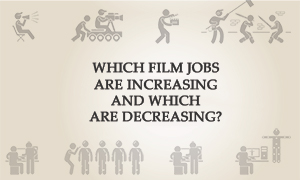
Earlier this year, I looked at how many people work on a film, and how that figure has shifted over time (up from around 200 in the year 2000 to around 300 today).
This prompted a number of readers to get in contact to ask about the changes in more detail. i.e. which jobs were becoming more common and which were declining.
To answer this, I studied the credits of 7,905 feature films which were released in North American cinemas between 2000 and 2018, inclusive.
There are so many jobs on a film set that I have opted to pick out the most extreme ones, as they also neatly tell the overall story. Let’s start with the jobs which are booming.
Jobs which are increasing
The largest shift among film crews over the past twenty years has been the massive increase in visual effects jobs. The average film in 2018 hired four times as many VFX crew members as the average film in 2000.
This reflects a change in mainstream cinema, led by what VFX can do. There are some tasks which were previously achieved with physical processes but the vast majority are wholly new effects. We can see this in the comparative number of people employed in the special effects department (i.e. physical, practical things) and visual effects department (i.e. digital, virtual effects).
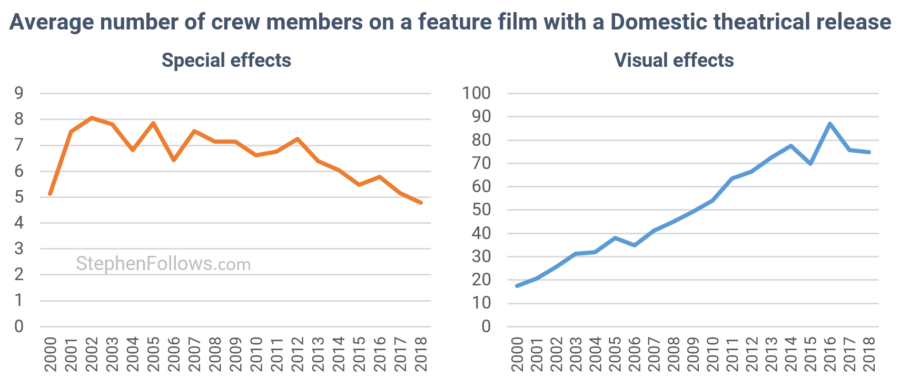
The four fastest growing credits over the past two decades are all visual effects jobs.
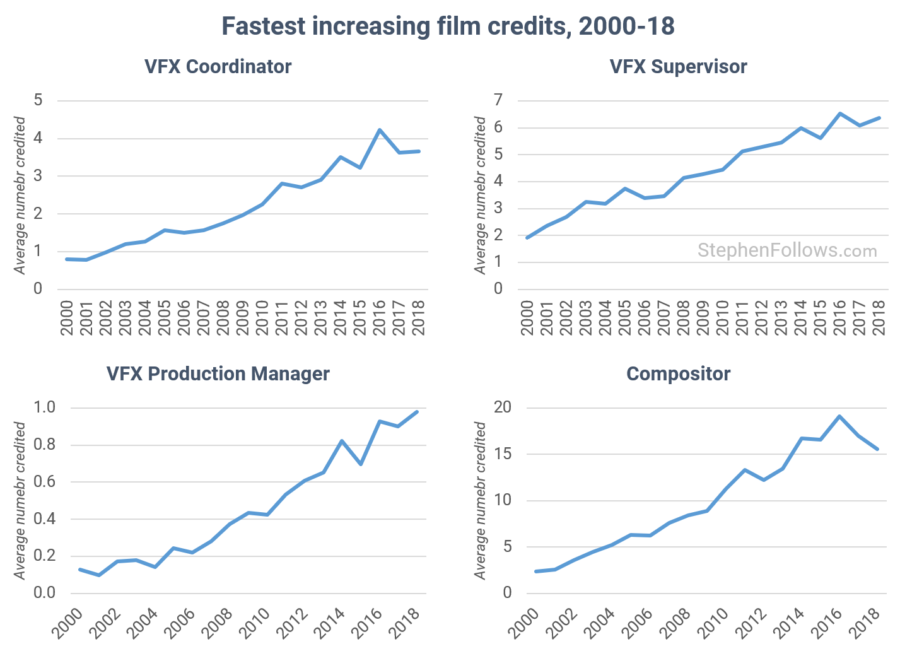
Outside of visual effects, other jobs which are fast rising include location coordinator, costume buyer, mix technician (within the sound department) and standby props.
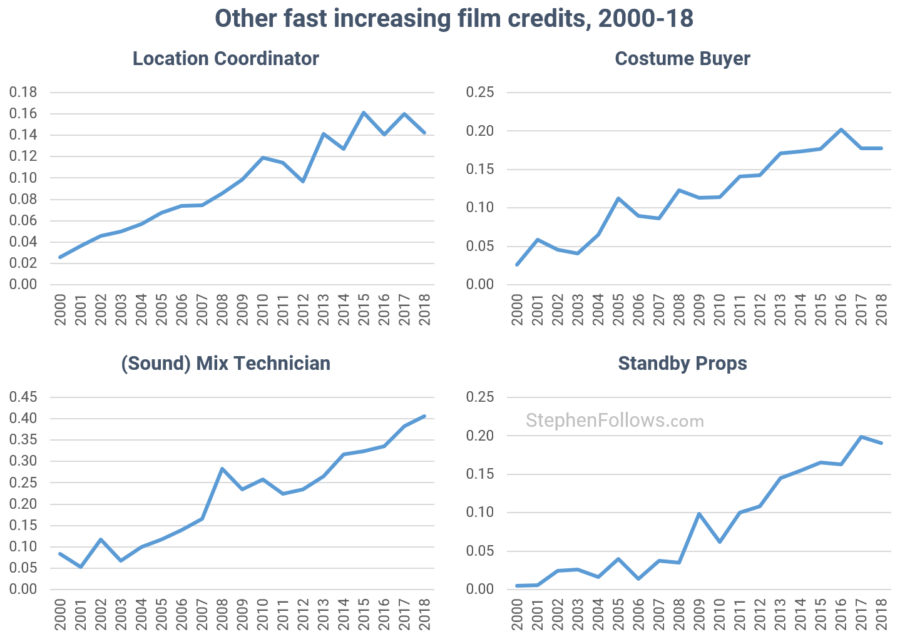
Jobs which are declining
At the other end of the spectrum we see a reflection of the industry’s move away from physical processes to digital ones. The largest declines are found in jobs which relate to physical post-production processes, such as optical visual effects, color timing (grading the image physically) and jobs involving handling the celluloid negative.
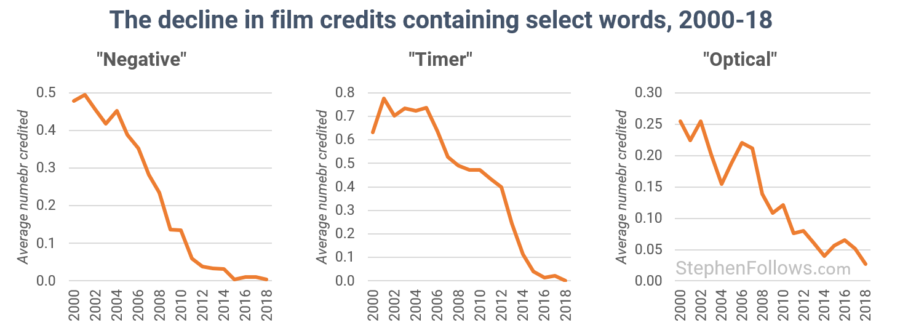
It’s not just post-production jobs which have been affected. The camera department has seen a steady decline in credits referring to film loader and, not so intuitive, focus puller.
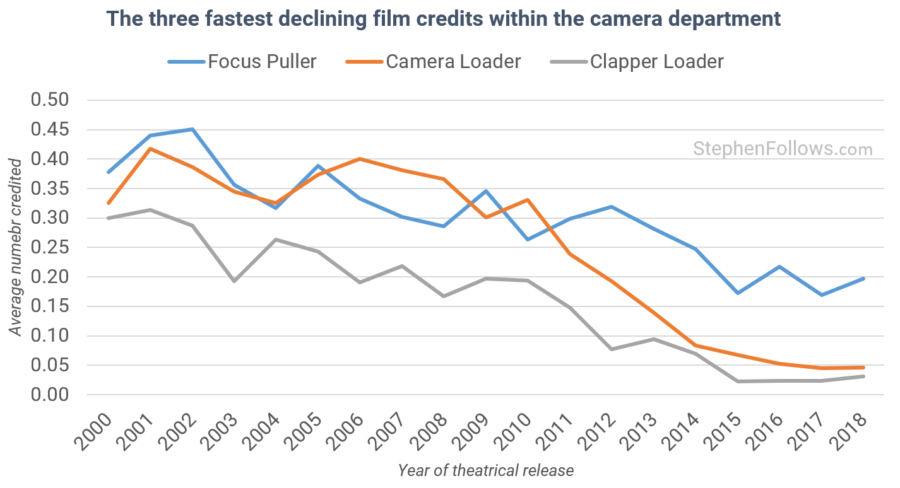
Other film credits which are in decline include sound editing, sound effects and wardrobe supervisor.
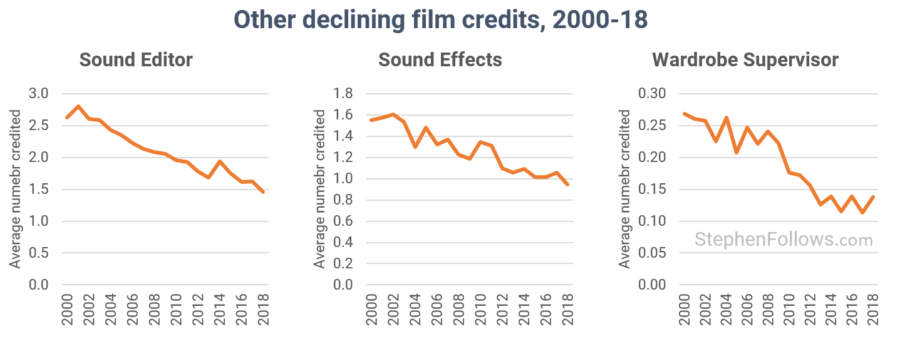
Cultural shifts in crediting
So far, we’ve talked about how the work people perform has changed, but there is another influence on how someone may be credited for their work – that of the culture around credits.
This sees credits as a subjective construct influenced by consensus and power, rather than as hard fact. For example, it could be a fact that you worked a day on a film set but whether your work was best described by the term “Runner” or “3rd Assistant Director” is a matter of opinion and culture.
This is affected by two major forces, namely:
- Choices made by people in power, such as department heads or the film’s producers. For example, studios routinely place a cap on the number of credits a visual effects house can submit, meaning many people’s work goes unacknowledged in the official credits roll (more on that here).
- Restrictions from third parties, such as union rules. Some unions dictate the number of credits which can be awarded (i.e. the DGA only allows one director), some have complicated crediting rules (such as the WGA’s system for writers), while others don’t dictate crediting rules (i.e. there are no such rules for producers).
A good example of a cultural shift is within the stunts department. The chart below shows the average number of people whose credit simply read “Stunts”.

At first glance, a casual observer may conclude that films are hiring fewer stunt professionals. However, if we change our focus to look at other credits within the stunt department, a different story emerges.
The use of the credit “Stunt Performer” have boomed, with increases also seen among uses of “Stunt Double”, “Stunt Driver” and “Stunt Rigger”. These definitions are more precise and possibly even more respectful than simply saying “Stunts”

A couple of years ago, I studied the use of the credits “Cinematographer” and “Director of Photography”, which often refer to the same job. I found that there was a cyclic nature to the choice, with Cinematographer overtaking Director of Photography in the late 1990s and again in the early 2010s.

There were also cultural differences between different genres of movie and among film crews in different countries. You can read the full research into “Cinematographer” and “Director of Photography” credits here.
Next week, I’m going to look at the hiring of trainees and apprentices.
Notes
The raw data for today’s research came from IMDb and Wikipedia. I opted not to include data from 2019 as movie credits can sometimes take a while to be added to credit listing sites.
Our unit of measurement is ‘credits per movie’, which takes the total number of a particular credit in a year and divides it by the total number of movies released that year. I used this method as the number of movies released each year has been increasing, so the raw number of such credits has increased.





Comments
Hi
these changes in camera department and FX are not really surprising, bearing in mind the change in technology sibce advent of Digital – what might possibly be more interesting is the change in production credits from Production Manager , Associate Producer , unit manager etc to whatever they go by today ~(principally the ubiquitous Exec producer??? ) , as per the quote from State and Main:
“What’s an associate producer credit?”
“It’s what you give to your secretary instead of a raise.”
best
David
Hello,
Why is there a decline in ‘sound editing’? Who else is going to do this job there is no crossover credit. Any ideas why its declining?
Certainly one major dept that is ‘new’ is that of Intimacy coordinator ?
This apparently falls under ‘ movement’ choreographing but is a skill that requires specialist training.
it would be good to see how many ‘ countries’ now either must have an intimacy coordinator or are getting up to speed with how they work ?
Hi end TV (Gentleman Jack) etc certainly started it here but with drama schools now needing to hire specialists plus the area of ‘ auditions’…?? In the light of the ‘ new world ‘ of Covid19 some good research into this fascinating and timely skill would be invaluable.
I wonder whether the decline in clapper loaders means that people aren’t using clapperboards anymore, or if that job falls to someone else in the crew?
The clapperboard is used to give information to the editor. It provides the info they need to know what the clip is, whether it has sound and how to sync the sound back up when recorded independently (which is almost always). In the digital age, those functions are still needed. The editor will want a quick way of seeing what the following scene is, and sound is still recorded separately and sunk-up afterwards (albeit there are now easy tools that can do it automatically by comparing to the camera’s low-quality ‘guide track’). But it also has cultural uses to as film crew. It signifies the start of a scene, it conditions people to prepare, etc.
My suspicion that there’s not one fewer person in camera depts, but rather the job has reverted to its other name, Second Assistant Camera (2nd AC).
Hi, I wanted to know that who earns more money in the VFX industry freelancers or corporate employees?
Is the acting job also in decline?
In addition to the role of intimacy coordinator, safety officers, and sustainability officers will continue to assert themselves in the filmmaking process.